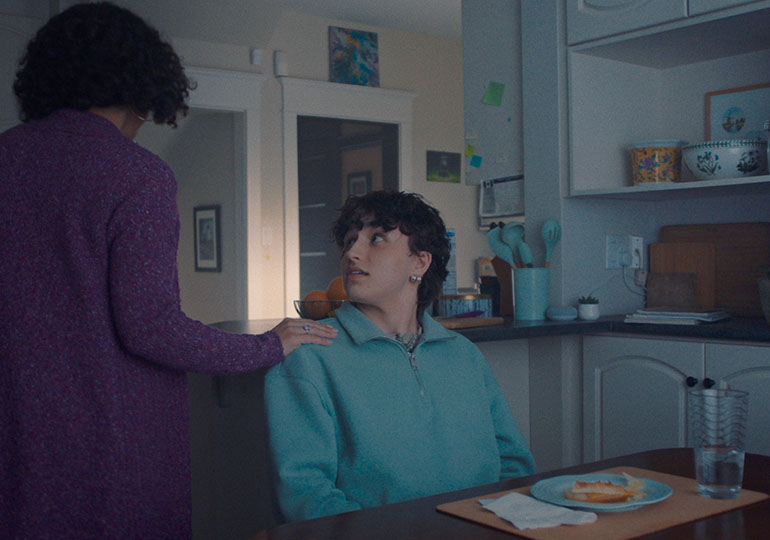There are many factors that can impact your mental health and it’s common to feel down from time to time. School and work stress, dealing with bullying, going through a breakup or experiencing a loss are some examples of things that can make you feel overwhelmed or defeated. These things may start to feel unbearable when you’re unsure what to do next, feel unsupported or if your usual coping strategies aren’t working for you. When people feel this way, they may have thoughts of suicide.
Having thoughts of death or dying can be scary and confusing. While experiencing thoughts and feelings about ending your life may not necessarily mean you want to die, it can be a major warning sign. It’s important to get help when you start to notice yourself having thoughts of suicide, death or dying. With the right support and a range of coping strategies, it’s possible to lead a fulfilling and satisfying life. Here, Kids Help Phone shares coping strategies for navigating thoughts of suicide, prompts you can follow to create a safety plan and tips for opening up to others.
If you’re having thoughts about suicide right now, it’s important to know that help is available. You can reach a Kids Help Phone counsellor by phone or Live Chat, or connect with a crisis responder through text. If you’re in crisis or in danger of harming yourself (including suicide), contact emergency services or a mobile crisis team in your area (if available) to access immediate support. No matter what you’re feeling, you’re not alone.
How can I cope with thoughts of suicide?
Having thoughts of suicide can feel isolating, uncomfortable and overwhelming. The topic of suicide can bring up feelings of shame and confusion that make it difficult to talk about openly. Many people experience thoughts of suicide and it’s important to know that feeling this way is not a sign of personal failure, weakness or a character flaw.
If you start to notice that you’re thinking about suicide, here are a few ideas to help you cope:
- Name your emotions (“I’m feeling sad/angry/afraid”, etc.): remind yourself that you are more than what you’re feeling and that the emotions you’re experiencing are temporary and will eventually pass
- Refocus your emotions and energy with an activity you enjoy: try colouring, drawing, journaling, watching a funny show, listening to music/a podcast/an audiobook, spending time outside, exercising, etc.
- Practise mindfulness: notice what’s happening in your body and mind to reflect on how you’re feeling without judgment
- Try grounding techniques: follow a breathing exercise and release tension in your body
- Visualize your favourite place: what does it look like? how does it feel? what do you notice? what are you doing there?
- Spend time with someone you care about: virtually or in-person
- Refer to your safety plan: use the prompts below to create a safety plan to help you cope and find support if you’re feeling overwhelmed
How can I create a plan to keep myself safe?
Creating a safety plan when you’re calm or feeling more positive can help support you if you’re in crisis. It’s OK if your plan changes over time as you find coping tools that work better than others or discover new ones. You may find it helpful to complete your safety plan with someone you trust (e.g. with a school counsellor, crisis support line worker, family member, etc.) who can offer perspective, provide suggestions and keep a copy of your safety plan, if you’re comfortable with it.
The image below shows one example of how you can format your safety plan. Consider where you want to keep this information — in a specific folder on a computer, in a journal or notepad, on an app or in phone/tablet notes, in your top drawer, as a voice recording, etc.

Download a fillable safety plan
Download a printable safety plan
Identify triggers and sources of stress
If you’ve experienced thoughts of suicide before, you may be able to recognize specific patterns, situations or events that make you feel less like yourself (e.g. noticing yourself withdrawing socially or losing interest in things you usually enjoy). Knowing what triggers you or causes you to feel stressed, overwhelmed, tired, sad, etc. can be important information to help keep you safe.
- Triggers and stressors I can be aware of:
Notice warning signs that you’re in crisis
Similar to identifying triggers, you may notice thoughts, feelings, body sensations or behaviours that mark a shift in your mental health and ability to cope. This could mean withdrawing from others, detecting a change in your mood, feeling angry, having difficulty sleeping, etc. It’s important to remember that experiencing or noticing each of these feelings on their own may not mean you’re at risk. Each person’s warning signs are unique, and you know yours best. By tuning in to your own warning signs that you may be in a crisis, you can reach out for support and/or try a coping tool before things escalate.
- Warning signs I can be mindful of:
Reflect on your reasons for living
Make a list of your reasons for living. What brings you joy? Who are the people/creatures that uplift you? What are your interests, hobbies and passions? What are you goals and hopes for the future? What are the things that make you uniquely you?
- My reasons for living:
Note your go-to coping strategies
Reflect on the strategies you’ve found the most helpful for working through difficult emotions and check in with yourself about what could be most helpful to try in the moment. These can be things like chatting with a close friend, watching a movie, meditating, making art, or other ideas from the list above. You may also want to consider alternatives to try if a coping strategy that usually works isn’t calming you down.
- My go-to coping strategies:
List professional and personal support
Make a list of the names and contact information of people who can support you. You can get specific about how each person can help (e.g. “person x helps distract me”, “person x is a great listener”, “person x can give me a ride to an appointment”, etc.). Include people you can connect with if you’re in active crisis (e.g. who can help you get professional support, bring you to an emergency department, etc.). You can also consider alternatives for support ahead of time (i.e. if the person you’ve decided to call isn’t available, who would be your second go-to?).
- My contact list of support:
You can also use Kids Help Phone’s Resources Around Me database to find support services in your area.
Create physical safety
Consider ways to keep yourself safe wherever you are. Think of places you feel comfortable going to outside of your home (e.g. a friend’s house, community centre, place of worship, library, youth shelter, etc., depending on public health guidelines in your area) where you can find support if you’re struggling. This can be especially difficult while adapting to changing COVID-19 restrictions and/or in rural communities. Consider what community you can connect with to help support in creating physical safety for yourself. Come up with a plan to get rid of or lock away things that could be used to harm yourself, and practice precautions like taking care of yourself if you’re using substances.
- Things I can do to keep myself safe:
How can I open up to someone about my thoughts of suicide?
It’s understandable to want to shut yourself off from the rest of the world or withdraw from people around you, and it takes courage to open up about something so painful. However, talking with someone about what you’re going through can be very helpful.
Choose someone you trust
Think of a person in your life that you feel comfortable opening up to — someone you trust and feel respected around. You can also refer to your contact list from your safety plan. Even though you may feel alone, someone is always available to listen.
Plan ahead
It’s OK if you don’t know how to start the conversation. Thinking through some ideas in advance (and/or practising letter writing or journaling) can help you to think more clearly in the moment if you’re nervous or stressed. Ahead of time, you can tell the person that you need to talk about something serious and find a time when you aren’t rushed and won’t be interrupted. Think about what your needs and/or hopes for the conversation are: do you want this person to listen, help you come up with next steps, connect you with support, etc.
Be honest
Being open during the conversation can help the person listening more fully understand what you’re going through and know how to help. This could include telling them if you have thoughts of suicide, if you’ve taken any actions so far or if you’re planning to take action in the near future.
The person you share with may have a reaction to what you are saying. If someone doesn’t know what to do or how to help, this can also bring up strong feelings in them. If you don’t feel like the conversation is helpful, don’t lose hope. Try speaking to someone else to get the help you need by referring to your safety plan. Your thoughts and feelings are important and you deserve to feel supported.
Where can I find more tools and positive coping strategies?
If you’re having thoughts of suicide, you don’t have to navigate them alone. You can refer to your safety plan, try different coping strategies or talk to a safe adult such as a doctor, teacher, Kids Help Phone counsellor or crisis responder. Help is available no matter what you’re going through.














